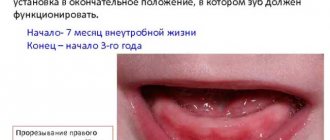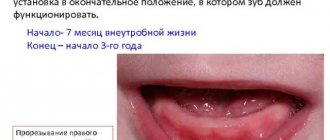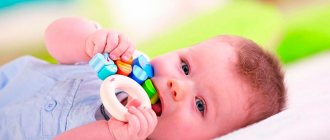Teething order
Is your baby about to turn 6 months old and are you noticing some anxiety in his behavior? This is natural, because the time of teething comes. And this is a difficult period in a child’s life.
The timing of teething in children can vary widely. Normally, the first teeth begin to appear closer to 6 months.
But it happens that baby teeth erupt earlier or much later. And there is nothing terrible here; this process is associated with the constitutional characteristics of the child.
- If you follow the pattern of teething in children, the central incisors on the lower jaw appear first. This usually occurs at 6-10 months.
- The upper central incisors appear at 8-12 months, and the first molars at 13-19 months.
- The canines “wake up” last – by 16-22 months.
- By the age of 2, a child usually already has 20 teeth, and from 6 to 12 years, baby teeth are gradually replaced by permanent teeth.
- Wisdom teeth do not have a milky version and appear in late adolescence.
What is constipation?
Experts diagnose constipation if the baby does “big” things:
- regularly and without problems, but at the same time dry and hard feces are released;
- with difficulty - the child has to push, feces do not come out on the first try;
- less than 5 times a day.
In the first six months of life, constipation is a rather rare occurrence; rather, on the contrary, in the period from 0 to 6 months, 6–10 bowel movements per day is considered the norm. In breastfed children, defecation occurs more often, in bottle-fed children - less often.
Teeth from birth? It happens
In exceptional cases, children are born with teeth. As a rule, we are talking about the lower incisors. They are called (neo)natal teeth. They erupt within 30 days. Their root is mobile, not formed, and often such teeth quickly fall out.
This feature is fixed genetically - as a rule, the parents had the same thing, a characteristic picture is observed in the baby’s brothers and sisters. Doctors suggest removing such teeth to prevent them from entering the respiratory tract. But this is not a mandatory procedure, at the discretion of the parents.
Teething symptoms
The appearance of teeth causes some discomfort in children, which affects their behavior and general condition. In the support chat for the online course “For Every Mom,” we will look in more detail at the main symptoms and means of helping the child and mother. May this period pass as calmly as possible for you.
Teething has accompanying symptoms that will help you understand the cause of these changes:
- Salivation
- Irritation and rash around the mouth
- Change in stool (usually loosening)
- Runny nose
- Temperature increase
- Anxiety
- Moodiness
- Sleep disturbance
This process is not fast. Discomfort may occur several days before gum eruption. If this stage is delayed, they speak of difficult eruption.
There is no reliable information about why the temperature rises during teething in children. It can be assumed that this is a preventive protective reaction of the body. After all, as a result of teething, a tooth creates a wound in the gum, and the body proactively turns on a protective mechanism in the form of inflammation and an increase in temperature. This is necessary to prevent infection of the wound surface...
How to help your baby teething
The arrival of a newborn in a family is an indescribable joy. Great relief comes when the period of infant colic passes. And as soon as moms and dads relax and begin to enjoy life, a new problem appears - teething. And it all starts all over again...
In order to somehow help their baby, parents are ready to do anything: buy it, apply it to the teeth, cover it up, drop it in, etc. During this period, advertising on TV fits very “successfully” - “Drops for teething.” Parents run to the pharmacy, give the child a miracle remedy, but there is no result. Another advertisement is “Teeting Gels.” Hurry to the pharmacy. But there was still no result.
STOP! In this situation you need to stop. Remember that people have been living on the planet for a long time. And children are constantly faced with teething. Yes, sometimes it brings discomfort, both to the baby and his entire family. But that's completely normal! You just have to be patient a little and you can forget about teething like a bad dream.
Medicines for teething
The first thing parents think about when faced with the problem of teething is how to help the baby? What products can I buy at the pharmacy? Let's look at all their diversity.
Gels with local anesthetics
At the moment, there are 2 painkillers contained in dental gels: benzocaine and lidocaine.
1. Benzocaine.
Benzocaine has been banned for use by the US Food and Drug Administration (FDA). The reason for the ban is toxicity and lack of safety. Products containing benzocaine can cause methemoglobinemia, the main symptoms of which are a gray-brown color of the skin, lips and nails, headache, shortness of breath, tachycardia, nausea and even death.
These symptoms may appear minutes to hours after using benzocaine.
2. Lidocaine.
This remedy can cause numbness in the throat and, consequently, impaired swallowing function. If the dosage is not observed, disturbances in the functioning of the cardiovascular system, convulsions, allergic reactions, anaphylactic shock and death occur.
Since 2014, lidocaine has been banned for use in children's teething by the American FDA.
Homeopathic gels
There seems to be nothing wrong with homeopathy - after all, there is no active ingredient in such preparations. And if children become calmer after them, then we can remember the placebo effect. They smeared the gums - the parents calmed down - the child calmed down.
However, there is still a catch. In 2016, a number of homeopathic dental medications were recalled due to the discovery of toxic concentrations of belladonna in these products. As a result of the use of these drugs, children experienced convulsions, difficulty breathing, and lethargy.
Herbal gels and anti-inflammatory agents
Theoretically, these drugs can be used, but we should not forget that they can be washed out of the oral cavity after just a few minutes. From this it is clear that the effect of them will not last long and the child will start crying again. At the same time, you need to remember about the likelihood of allergic reactions and individual intolerance.
What then to smear?
Nothing. The American and Canadian Dental Associations do not recommend any gels for use in children during teething.
How parents can help their baby:
1. Give your child pre-cooled rubber or silicone teethers. If they contain liquid inside, they should be chilled in the refrigerator rather than the freezer. When cleaning teethers, do not boil them, as high temperatures can damage the plastic.
2. Offer your baby teething toys with a ribbed surface made of silicone or latex.
3. If the child has already learned to eat solid foods, offer him chilled pieces of fruits and vegetables, as well as dried fruits. This is a good way to distract your child from painful sensations. The main thing is to be close to the child at this time and make sure that he does not choke.
4. Offer your breast more often (if breastfeeding). The baby calms down thanks to the action of several factors at once: massage of the gums, proximity to the mother and the soothing effect of the milk itself.
5. Give chilled water from a sippy cup or bottle (suitable for children over 6 months).
6. Massage the baby’s gums with clean fingers or special silicone fingertips.
7. Just be there during this difficult period, hug, hold, stroke more often and try to distract.
8. If pain is severe, give your baby painkillers (you need to consult your pediatrician!). Children's Nurofen or Paracetamol will help relieve pain. The dosage is calculated based on the child's weight.
9. The American Academy of Pediatrics gives advice that is rather unusual for a Russian person: let your child chew wet rags or socks that have been pre-chilled for 10-15 minutes in the refrigerator.
10. Constantly wipe excess saliva from your baby's lips and chin. This will prevent irritation and thereby ease the baby’s suffering. Additionally, you can apply a neutral baby cream to the mouth area.
Do not worry. After all the “torment” the teeth will finally appear. And now your task is to keep them clean and healthy. Solemnly hand your baby his first toothbrush and baby toothpaste (0+), and feel free to brush your teeth morning and evening.
How to make teething easier
- First of all, it is necessary to remain calm and reassure the child that everything is under control and soon his suffering will end.
- Teething is accompanied by itching in the gums, which forces the child to chew on any hard objects. Provide him with clean and safe teethers - special rings, toys, rags.
- Cold significantly relieves pain and itching in the inflamed gums. You can pre-cool the teether in the freezer, apply ice wrapped in a cloth or bandage for a short time.
In medicine, during teething, special gels are actively used, which are applied to the gums at the site of inflammation: “Cholisal”, “Dentinox”, “Kalgel”... All of them have a local anesthetic effect. And any anesthesia has a detrimental effect on the body, suppressing its defenses.
However, you can ease your child’s suffering while strengthening his immunity. Homeopathy will help you with this. This method is very effective and safe for the baby.
How to choose a teething remedy
The eruption of baby teeth is a physiological process that usually begins around 4-6 months of a child’s life and ends at about two and a half years. Regularly occurring symptoms of teething: restlessness (especially at night), increased salivation, itching, swelling and soreness of the gums. Any mother, naturally, wants to make this period of development easier for the child, relieve pain in the gums, and reduce the likelihood of sleepless nights. Therefore, mothers very often ask doctors questions: what to do when teething and how to help the child?
There are several solution options with their advantages and disadvantages:
1. Homeopathic remedies.
On the one hand, ingestion of diluted chamomile and other herbal ingredients will calm the baby, however, from the point of view of scientific medicine, they are unlikely to have any direct effect on the gums.
| 2. Systemic pain relievers (eg paracetamol, ibuprofen) They are safer, but they will also act on the baby’s body in general, and not on the gums. 3. Gels based on lidocaine or benzocaine These are local anesthetics that have an analgesic effect during teething. But there are several nuances: • Firstly, with frequent use, lidocaine and benzocaine can have a toxic effect on the body of a small child. In 2014, the US Food and Drug Administration (FDA) reported 22 cases of severe adverse events to 2% lidocaine gels in children under 3 years of age. Side effects of lidocaine included respiratory distress, decreased heart rate, decreased blood pressure, and convulsions. That is why the Department has imposed a ban on gels with high levels of it. • Secondly, age restrictions: usually from 3 or 6 months. If your baby starts teething early, these medications will not help him. In addition, such gels can have a very specific taste, and the baby may completely refuse to use it again. |
4. Gels based on natural extracts without synthetic anesthetics
These gels are based on extracts that have anti-inflammatory, analgesic and antiseptic effects.
For example, the new Italian gel for gums Dentinale® natura with herbal ingredients: aloe vera juice, boswellia and chamomile extracts, will help postpone the teething period without resorting to analgesics and anesthetics.
Dentinale® natura has a mild anti-inflammatory and antiseptic effect. The gel does not contain :
• synthetic painkillers
• sugar
• parabens
It is almost impossible to overdose on such a drug, it is harmless if swallowed, side effects are not described and theoretically can only be associated with individual intolerance to the components of the gel.
Pleasant to the taste and has no age restrictions.
Easy teething and good nights!
PRODUCTS BY THEME: Dentinale
You can read the reviews at the link: https://www.babyblog.ru/td/itog/41
Chamomilla
- A child in the Hamomilla state is capricious and irritable. He kicks, bites, fights, asks to be carried.
- He may demand one toy or another, but having received what he wants, he instantly loses interest in it and throws it away. Malaise is accompanied by outbursts of anger.
- The condition worsens at night, better from motion sickness (in the car, in a stroller). Strong-smelling, green, lumpy stools. A characteristic detail is that one cheek may be red and the other pale. The head sweats profusely, the sweat is hot.
Calcarea carbonica
- Children of this type are well-fed, chubby, but have flabby muscles. During sleep, the Calcarea child's head sweats, especially the back of the head. Sweat has a sour smell.
- These are children with late teething; the teething process itself is long. Such disorders are associated with calcium deficiency, which is poorly absorbed in this constitution.
- Tendency to frequent colds and ear infections. A passionate desire for eggs (especially soft-boiled ones), cheese and milk, as well as sweets is a sure sign of a calcareous child.
- He is worse in cold damp weather, better in warmth.
Calcarea phosphorica
- A child in the state of Calcarea phosphorica is fussy, runs somewhere all the time, complains of boredom, whines. He wants to be entertained.
- The teeth of such children appear slowly and late, immediately grow bad and weak, and quickly decay.
- People of this type do not like drafts, they feel worse in the spring, better in dry, warm weather, lying down.
These are the main homeopathic remedies that are suitable for difficult and painful teething in babies. To learn to see the symptoms, understand the processes occurring during illness, be able to select remedies, create your own family homeopathic first aid kit and use it on occasion, we invite everyone to the video course on children’s health “For Every Mother”.
Go to video course
Not according to the rules
And yet, in the first 6 months, constipation in infants is not excluded. They can call him:
- microflora transmitted from mother;
- insufficient fluid volume;
- stress.
Let's say a woman has too many bacteria in her stomach and intestines that produce methane, which causes constipation. They grow rather slowly, ferment, releasing carbon dioxide, which promotes flatulence and bloating. The woman lives with this deviation, has adapted and learned to solve the problem with the intestines in one way or another. Noticing the same thing in the child, she decides that the baby has inherited her characteristics and “saves” him using the same means, making a mistake. Babies should not be given laxatives, especially those containing senna. The baby’s body gets used to such drugs too quickly and can no longer cleanse the intestines without them.
Constipation in a baby under 6 months is also caused by a lack of fluid and hormonal changes. At 6 months, the baby should receive a lot of moisture - approximately 140 ml per kilogram of weight per day. A breastfed baby gains this amount from mother's milk and does not need additional sources of fluid (but only if there is no predisposition to constipation). Little artificial babies are given extra food from the moment they switch to formula.
If a woman is tense or nervous, her level of the stress hormone cortisol increases. The substance enters the baby's body through breast milk, saliva or sweat and also causes constipation.
Even if the mother does not breastfeed, microorganisms that cause constipation sooner or later reach the baby’s gastrointestinal system and produce negative changes in it.









